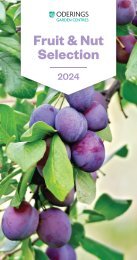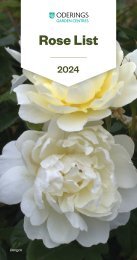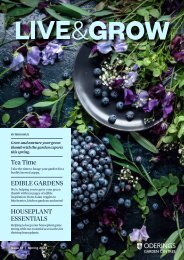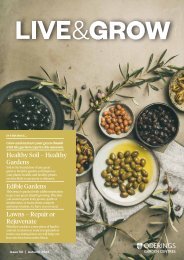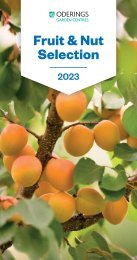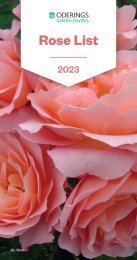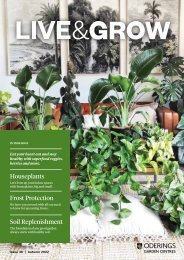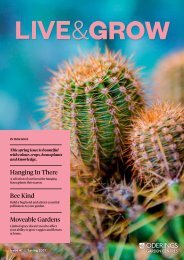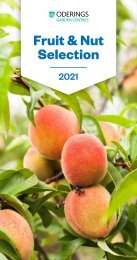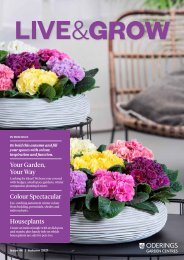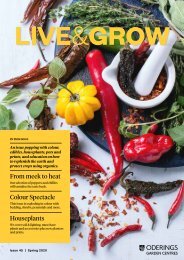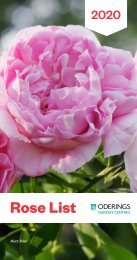You also want an ePaper? Increase the reach of your titles
YUMPU automatically turns print PDFs into web optimized ePapers that Google loves.
<strong>2020</strong><br />
<strong>Fruit</strong> & <strong>Nut</strong><br />
<strong>Selection</strong><br />
www.oderings.co.nz
ALMOND<br />
Most almonds are self-fertile and do not require a cross pollinator.<br />
All In One – Number one for home orchards. Heavy crops of soft-shell<br />
nuts with sweet, flavourful kernels. Hot summer required to ripen.<br />
A five-metre tree, very winter and frost hardy. Self-fertile. Available SI<br />
Garden Prince – A delightfully compact-growing tree that is both very<br />
ornamental and fruitfully productive. It commences fruiting from a<br />
young age and has very heavy crops. Grows to approximately 3m tall<br />
and 2.5m wide and is self-fertile. Available All Stores<br />
IXL – Producing large oval nuts that have a sweet flavour. The tree<br />
has a neat upright habit and is a great producer. Partially Self-fertile.<br />
Pollinate with Monovale. Available CB<br />
Monovale – Produces hard-shell nuts with good flavour. Due to their<br />
strong flavour this variety can be used for Marzipan. A heavy cropper<br />
and good pollinator. Disease hardy variety. Vigorous grower, self-fertile.<br />
Available SI<br />
APPLE<br />
In most areas apples are often pollinated by other apples or<br />
crabapples close by. If unsure, you will need to plant two varieties that<br />
cross pollinate. Please see in-store details.<br />
• M9 – Dwarf fruit tree growing to 3m. Suits well drained, fertile soils.<br />
Not suitable for heavy clay soils.<br />
• MM102 – Similar to MM106 but performs better in wetter sites.<br />
• MM106 – Semi dwarf fruit tree growing to 4.5m. Good for most soils<br />
except poor-draining sites.<br />
• M26 – Proven industry work horse. Recommended for high density<br />
plantings on all sites except poorly drained soils.<br />
Single Apples<br />
Apple Baujade M26 – French Granny Smith–type apple ripening late in<br />
the season. Medium sized, sweet and aromatic. Well suited to warmer<br />
areas. Available SI<br />
Ballarat M102 – Ballarat is a heritage Apple which bears large apples<br />
that are ripe towards the end of April. The fruit are green with a red<br />
blush and the cream flesh is lovely and juicy. A great apple for cooking<br />
- it stores very well too. Available CB<br />
Ballerina Bolero – Attractive white tinged pink spring blossom,<br />
followed by shiny green eating apples with a golden blush. This spur<br />
bearing variety ripens mid season. Available SI<br />
Ballerina Polka – Medium-size round fruit with green skin. A red blush<br />
develops in areas exposed to the sun. The flesh is crisp and juicy with a<br />
very good flavour. Matures mid-season. Available All Stores<br />
Ballerina Waltz – Medium to large round-conical fruit with a solid red<br />
skin on exposed areas. Crisp and juicy with a slight tang. Suitable for<br />
fresh fruit, drying and cooking. Matures mid-season. Available All Stores<br />
Blush Babe 60cm Standard – Growing to just two metres tall with a<br />
mop-head habit, this dwarf apple variety produces delicious full-size<br />
crispy red fruit. Good natural disease resistance means little spraying is<br />
required, and little or no pruning is needed. Self-fertile. Available All Stores<br />
Braeburn M26, MM102 or MM106 – Braeburn apples have a unique<br />
combination of sweet and tart flavour and are medium to large in size.<br />
They are a popular fruit for growers because of their ability to store<br />
well when chilled. Available All Stores<br />
Coxs Orange Pippin M26, MM102 or MM106 – One of the finest apples<br />
ever grown. Rich aromatic nutty-flavoured flesh makes this older variety<br />
still a hugely popular apple. Early to mid-season. Available SI<br />
2<br />
SI – South Island, PN – Palmerston North, HN – Havelock North,<br />
N – Napier, CB – Cambridge
Fuji M26 or MM102 – Super sweet, super juicy, super crisp Japanese<br />
apple. Stores very well for several months. Colour ranges from light<br />
green-yellow with a small amount of red, to fully red. Available SI – M26,<br />
Available CB – MM102<br />
Golden Delicious MM106 – World famous apple with great taste,<br />
texture, aroma and appearance. Honey flavoured, very sweet<br />
especially when tree ripened. Heavy and regular producer in late<br />
season. Available SI<br />
Granny Smith MM102 or MM106 – Aussie classic with large green fruit<br />
with white tart crisp and juicy flesh. Well balanced flavour. Late and<br />
long picking season. Excellent keeper. Regular bearer that suits most<br />
climates. Available All Stores<br />
Harold Red Delicious MM102 – This is a NZ selection of the popular<br />
‘Red Delicious’. The skin is a very deep red colour and the aromatic,<br />
juicy flesh is coloured cream. Ripens in autumn. Available CB<br />
Hetlina MM106 – Reliable crops of medium-size firm and crisp red<br />
fruit that are good eating. Early season apple on high-health tree.<br />
Available SI<br />
Initial M26 or MM106 – An exceptionally good eating red coloured<br />
apple, with high aroma, low acid and high sugar. Easy to grow and<br />
tolerant to a large range of apple diseases and pests. Early fruiting.<br />
Available SI<br />
Lady in Red (Pink Lady) M26 or MM102 – ‘Lady in Red’ tree bears<br />
fruit that is pink-red blushed with pure white flesh and is capable of<br />
producing fruit that meets the high quality standards of PINK LADY®<br />
apples, one of the world’s most popular varieties. <strong>Fruit</strong> from this ‘Lady<br />
in Red’ tree has a flavour balanced between tartness and sweetness,<br />
with a crisp texture and sensational aroma. Available All Stores<br />
Monty’s Surprise M26 or MM102 – Crisp, good eating, late-ripening<br />
apple that also cooks well. <strong>Fruit</strong> can be very large on a vigorous, highhealth<br />
tree. <strong>Fruit</strong> is shiny red over light green background. Available All<br />
Stores<br />
Pacific Rose M26, MM102 or MM106 – This pink-skinned pleaser is<br />
firm and juicy, with a rich sweet flavour that won’t disappoint. This New<br />
Zealand variety has distinctive, clear rose-pink skin. The flesh is firm,<br />
crisp and juicy with a rich sweet taste. A Gala and Splendour cross, this<br />
apple reaches maturity mid-season. Available All Stores<br />
Peasgood’s Nonsuch M26 – Juicy fresh-eating apple with large<br />
regular shape. Cooks to a sweet delicately flavoured puree but also<br />
great baked or used in salads. Good regular cropper and reasonably<br />
disease-resistant tree. Available SI<br />
Red Gravenstein MM102 – Heritage Apple. An early season apple that<br />
ripens in summer. The fruit are striped and are medium to large. The<br />
flesh is very crisp and juicy with a ‘zingy’ flavour, eat fresh or use for<br />
cooking. Available PN<br />
Royal Gala M9, M26, MM102 or MM106 – This NZ-bred apple now<br />
surpasses Cox Orange as Britain‘s most popular eating apple. Creamy,<br />
fine textured, crisp, sweet and juicy flesh. Regarded as one of the<br />
world’s finest apples. Matures in February. Available All Stores.<br />
Splendour M26 or MM102 – Beautiful, large and blocky, carmine-red<br />
apples with creamy, very crisp flesh. Sweet and very low acid. Ripens late<br />
and hangs on the tree well. Fabulous winter keeper. Available All Stores<br />
Sturmer MM106 – Clear white flesh with blush bronze over green skin.<br />
Excellent cooking and dessert quality apple. Mid to late-season variety<br />
that is partially self-fertile. Heavier crops are produced when pollinated<br />
by another variety of apple such as Cox’s Orange Pippin, Discovery,<br />
Granny Smith, Jonathan, Kidd’s Orange Red and Scarlet Nonpareil.<br />
Available SI<br />
www.oderings.co.nz 3
Thumbelina Mini Apple Candy Crunch – A new variety with bitesized<br />
apples. The fruit is ripe after the leaves have fallen in autumn,<br />
usually in May in most regions. Sweet, crisp and juicy fruit with bright<br />
red skin. Pretty white and pink spring blossoms. Growing to just 2m tall.<br />
Available All Stores<br />
Double-Grafted Apples<br />
Double Delicious (Red and Golden Delicious) – Superb in spectacle<br />
and great eating, has both the golden and the red Delicious varieties.<br />
Available All Stores<br />
Royal Gala/Braeburn – Two hugely popular varieties that are<br />
excellent keepers when stored. Available All Stores<br />
APRICOT<br />
Most apricots are self-fertile; however, they will fruit more heavily and<br />
regularly if cross pollinated.<br />
Aprigold – Bears full-size, early season, highly coloured, tangy and<br />
flavoursome fruit. Grows to only 1.8m. Well suited to warmer areas of<br />
NZ. Self-Fertile. Available All Stores<br />
Castlebrite – A semi-sweet apricot, which is medium in size, reliable<br />
and early fruiting with firm, bright orange fruit with a slight red blush.<br />
Available PN<br />
Cluthagold – A cross between Sundrop and Moorpark. Cluthagold<br />
is a large, oval apricot with very good eating quality. Flesh is firm but<br />
melting, with very good flavour. Skin is orange with a lovely red blush.<br />
Available SI<br />
Fitzroy – Bred in Taranaki this Apricot has consistent crops of<br />
medium sized golden fruit that ripen around February. The fruit are<br />
sweet and juicy, and the tree is self-fertile. Happiest in the sun with<br />
good drainage. Prune after harvesting. Available HN, PN<br />
Garden Annie – Garden Annie is an early season fruiting variety, with<br />
good sized bright yellow fruit that are firm and juicy as well as being<br />
semi-freestone. A highly ornamental tree that is semi-dwarf, so is well<br />
suited to home gardens especially in the warmer areas of the country.<br />
Available All Stores<br />
Goldrich – Firm, deep-orange flesh is excellent for home preserving<br />
and eating. Best with a pollinator. Ripens late January and grows to<br />
approx. 3m high within 5 years but matures to 5m tall. Available CB<br />
Katy Cot – Large, all-purpose, flavourful, freestone apricot well suited<br />
to warm winter climates. Tree ripened fruit are incredibly good for<br />
eating and also make excellent jam. Early harvest. Self-fertile. Semidwarf,<br />
to 4m. Available SI<br />
Moorpark – Superb flavour, medium to large juicy, soft fruit. Midseason<br />
variety best suited for cooler climates. Eating, bottling or<br />
drying. Self-fertile Available All Stores<br />
Royal Rosa – Very early, freestone selection with tasty firm gold<br />
flesh and yellow skin with a red blush. Self-fertile. Relatively disease<br />
resistant, low-chill selection recommended for home gardens<br />
throughout the country. Available All Stores<br />
Sundrop – Excellent cropper with sweet and juicy yellow fruit with firm<br />
flesh over long season. Partially self-fertile but best planted with Trevatt<br />
for cross pollination. Suitable for many regions. Available All Stores<br />
Tomcot – A large, almost peach-sized fruit with a strong red blush<br />
over the orange skin. Freestone fruit with an intense flavour.<br />
A compact tree. Available SI, PN<br />
Trevatt – Large sweet, juicy, golden-yellow fruit. Mid to late season.<br />
Eating or bottling. Recommended for most areas. Pollinate with<br />
Sundrop. Available All Stores<br />
4 SI – South Island, PN – Palmerston North, HN – Havelock North,<br />
N – Napier, CB – Cambridge
Apricot Double<br />
Sundrop/Trevatt – Two top varieties combined, both being the ideal<br />
choice for most regions throughout New Zealand. Available All Stores<br />
CHERRY<br />
Some cherries are self-fertile, whereas others need a cross pollinator.<br />
Bing – Dark red with a beautiful, acidic, excellent flavour. Bing is the<br />
main cherry grown in the USA Pacific and Northwest, but fruit size is<br />
small. Available PN<br />
Burlat – Is the standard early season cherry with dark red skin and<br />
flesh. Medium to large sized fruit for its season. Available NI<br />
Compact Stella – Heavy and regular bearer of large dark red fruit<br />
with firm light-red flesh. Self-fertile and one of the best known sweet<br />
cherries. Grows to around 3m. Available All Stores<br />
Dawson – Superb eating black medium-size fruit with firm red flesh.<br />
Ripens just after Christmas. Pollinators: Lapins and Stella. Available SI, N<br />
Lapins – Large dark red fruit with firm juicy flesh. Self-fertile,<br />
precocious and now a commercial mainstay in many areas. Mid to late<br />
season. Available All Stores<br />
Montmorency – Most widely grown sour cherry in the USA. Great for<br />
cherry pie and juice. Bright red skin with white flesh. Amorelle-type<br />
cherry with clear juice. Self-Fertile. Available SI<br />
Rainier – Large super sweet, white fruit with red blush and white flesh.<br />
Early to mid-season. Pollinate with Stella. Available SI<br />
FIGS<br />
All figs are self-fertile.<br />
Brown Turkey – Well-known hardy selection with large crops of green<br />
figs with a distinguishing brown tinge. White to amber flesh. Eats OK<br />
but best for culinary uses. Available All Stores<br />
Brunoro Black – A prolific cropper producing two crops in warmer<br />
areas. Sweet, smallish dark-skinned fruit with red flesh. Attractive<br />
foliage with strongly divided leaves. Available All Stores<br />
Mrs Williams – Good quality, large fig that is earlier than most. <strong>Fruit</strong><br />
dark in colour, sometimes purple. Flesh colour is light amber to rich<br />
red. Available All Stores<br />
HAZELNUTS<br />
Merveille de Bollwillier – Highly sought-after later pollinator that<br />
produces quality large nuts on vigorous growing plant. Pollinators<br />
include Alexandra. Available All Stores<br />
Whiteheart – New Zealand’s most popular hazelnut, grown mainly for<br />
processing and its smaller size. Good crops of small round nuts. Good<br />
yields of medium sized nuts of excellent flavour. Pollinators include<br />
Alexandra, Auckland No. 2 and Merveille de Bollwillier. Available All Stores<br />
NASHI<br />
Nashi are self-fertile; however, they will fruit more heavily and regularly<br />
if cross pollinated.<br />
Hosui – Excellent eating, sweet and juicy with good acid balance and<br />
fine texture. Large russet golden-brown fruit. Partially self-fertile. Midseason.<br />
Available All Stores<br />
Nijiseiki – Very juicy, sweet, creamy white, crisp medium-size round<br />
fruit. Self-fertile and good pollinator of Hosui. Mid-season. Available All<br />
Stores<br />
www.oderings.co.nz 5
NECTARINE<br />
All varieties are self-fertile and will crop well on their own.<br />
Early Red – Very early to fruit with yellow flesh and red blushed skin.<br />
Good balance of sweet and tart flavour. Freestone. Good easing and<br />
fruit size. Available SI, CB<br />
Fantasia – An excellent yellow-fleshed selection producing large<br />
attractive fruit with very good flavour. Freestone. Low chill requirements<br />
so suitable for warmer climates. Late season. Available SI<br />
Firebrite – A medium to large sized fruit that has dark red blush over<br />
golden yellow skin. Sweet and juicy flesh. Excellent eating fresh or<br />
preserved. Early season. Available NI<br />
Flatto Sweet Button Bright – Produces large crops of sweet, tasty,<br />
yellow-fleshed fruit in mid to late summer. The fruit weighs between<br />
100g and 140g each. During spring, 50 blossoms cover each metre of<br />
branches. Available All Stores<br />
Flavourzee 60 or 70cm Standard – A dwarf nectarine with midseason<br />
yellow-fleshed fruit of good size and eating quality. Forms a<br />
compact bushy habit. Available All Stores<br />
Garden Delight 60 or 70cm Standard – Large juicy freestone fruit<br />
with red skin and yellow flesh. A low chilling requirement makes<br />
Garden Delight ideal for warmer regions. Attractive large pink<br />
blossoms. Available SI, PN, HN, N<br />
Goldmine – Medium-size white-fleshed freestone fruit that is juicy and<br />
sweet. Mid-season. An old favourite variety that is very productive.<br />
Available All Stores<br />
Mabel – A fabulous splash of burgundy-purple foliage for the home<br />
orchard with sweet purple-skinned nectarines in February. Very leaf<br />
curl resistant and suitable for all regions in New Zealand. Grows to<br />
3.5m tall and 3m wide. Available All Stores<br />
Nectar Babe 60 or 70cm Standard – Sweet yellow juicy freestone<br />
flesh. Deep-pink blossom. Low chilling requirement so good for warmer<br />
areas. Best planted with Honey Babe or near another nectarine or<br />
peach to aid pollination. Available SI, CB, PN<br />
Queen Giant – Very attractive large fruit with red-and-cream skin,<br />
ripening in mid-season. Very sweet pure white tender flesh. Freestone.<br />
Available SI<br />
Redfree – Has bright red skin and sweet, juicy, yellow flesh with a fine<br />
texture and excellent flavour. An ideal choice for the home garden with<br />
the fruit ripening in mid to late January. Semi-clingstone. Available HN, CB<br />
Red Gold – A large, proven late-season nectarine with a sweet flavour.<br />
Deep-red skin with gold blush and a deep-yellow flesh that easily<br />
separates from the seed. Available All Stores<br />
Snow Queen – Delicious creamy-white firm flesh with deep-red skin.<br />
Great eating. Early, large and freestone. Available All Stores<br />
Sunglo – Excellent older variety with good flavour and texture. Large<br />
yellow fruits splashed with red and ripen in February. Available PN<br />
Theo Ching – A mouth-watering white fleshed nectarine with good<br />
disease resistance. Harvest in January-February. Available SI<br />
PEACH<br />
All varieties are self-fertile and will crop well on their own.<br />
April White – Delicious large white-fleshed, firm peach that has an<br />
attractive pink blush. The tree is of medium vigour with a high resistance<br />
to leaf curl. Heavy cropper late in the season. Available All Stores<br />
Blackboy – Medium-size fruit with port-wine coloured skin and winered<br />
melting flesh. Eating and bottling. Good home-garden tree. Late<br />
6 SI – South Island, PN – Palmerston North, HN – Havelock North,<br />
N – Napier, CB – Cambridge
season. Available All Stores<br />
Bonanza 60 or 70cm Standard – Yellow freestone peach with red<br />
blush. The large fruit is sweet and low in acid, with a mild, refreshing<br />
flavour. Highly attractive in both blossom and fruit. Available All Stores<br />
Camden – A popular peach, producing medium sized yellow fruit that<br />
are very juicy with a rich flavour. Clingstone. Ripens around December.<br />
Available CB<br />
Coconut Ice – Large, round-oblate fruit with light pink coloured skin,<br />
white flesh and a crisp texture. Ripens in January and is low acid.<br />
Available All Stores<br />
Dixired – Good sized red skinned, freestone fruit with yellow flesh.<br />
Early season. Strong resistance to leaf curl. Best suited to cooler,<br />
temperate regions. A strong-growing tree. Available SI<br />
Elegant Lady – Produces blushed, red over yellow, large, round and<br />
very firm fruit with an elegant balanced flavour. Freestone and a heavy<br />
producer, ripening from mid-January. Available PN, CB<br />
Flatto Sweet Bonnet – Produces large crops of sweet, tasty, yellowfleshed<br />
fruit in early to mid-February. The fruit weighs between 100g<br />
and 130g each. During spring, 50 blossoms cover each metre of<br />
branches. Available all stores. Available All Stores<br />
Flatto Sweet Cap – A white fleshed variety with excellent flavour –<br />
delicious when eaten while still crunchy or equally tasty when left to<br />
soften slightly. Ripens late January to mid-February. The tree can grow<br />
to around 4m tall if allowed to. Available All Stores<br />
Garden Lady 60 or 70cm Standard – Large yellow-skinned fruit with<br />
sweet, juicy, yellow flesh. Freestone. Available SI<br />
Golden Grace – Prolific crops of medium-size red-blushed fruit in midseason.<br />
Flesh is yellow, very sweet, low acid and juicy. Clingstone. Well<br />
suited to the warmer areas of the country. Spreading tree. Available SI<br />
Golden Queen – Needs no introduction. A true favourite for bottling<br />
and an excellent eater. Firm deep-orange flesh. Clingstone. Late<br />
season. Available All Stores<br />
Gordon’s Glory – Clingstone peach with similar yellow flesh and<br />
flavour to Golden Queen. Very productive. Chosen for its resistance to<br />
Leaf Curl. Ripens in March. Available SI<br />
Healey’s Peacherine – This is actually a Peach/Nectarine cross with the<br />
advantage of being ‘fuzzless’ and bringing you the best of both delicious<br />
fruits. Medium to large fruit with smooth skin. Sweet and juicy yellow<br />
flesh. Ripens towards the end of summer. Self-fertile. Available PN, HN<br />
Honey Babe Dwarf 60 or 70cm – Medium to large fruit with orange,<br />
sweet juicy flesh and tangy flavour. Showy pink flowers. <strong>Fruit</strong>s best<br />
near other peaches or nectarines for cross pollination. Honey Babe will<br />
often be evergreen through the winter. Available SI, CB, PN<br />
Maycrest – This peach has firm yellow flesh and a good juicy flavour. It<br />
has bright red skin over a yellow background. The fruit is of a medium<br />
size and ready about December. Available CB<br />
Peacherine – Excellent eating and great bottler. Actually, a nectarine/<br />
peach cross. Medium to large firm fruit with smooth skins. Sweet and<br />
juicy yellow flesh. A late-season clingstone variety. Available All Stores<br />
Peachcot – Reputed to be a peach-apricot cross. Golden late-season<br />
fruit that are very sweet and tasty with a firm texture. A regular<br />
cropper. Available All Stores<br />
Pixzee 60cm Standard – Large red over-orange–skinned fruit with<br />
delicious firm yellow flesh. Freestone. Early to ripen. Available SI<br />
Red Haven – The industry standard peach variety for many years.<br />
Firm, yellow fleshed medium to large size fruit. Excellent flavour.<br />
www.oderings.co.nz 7
Freestone and mid-season. Consistent and proven performer. Available<br />
SI, PN, HN<br />
Scarlet O’Hara – White fleshed fruit with pink-red skin. <strong>Fruit</strong> is larger<br />
than Coconut Ice, firm and crunchy. Ripens mid-season. Available SI<br />
Show Grace – A sweet, juicy, low acid, white-fleshed peach. Prolific<br />
cropper with good-sized, round, red-blushed fruit. Clingstone. Available SI<br />
Sweet Perfection – A tasty freestone peach with red-pink skin and<br />
yellow flesh. The tree shows good resistance to leaf curl so can be<br />
grown without spraying. Available SI<br />
Wiggins – Old standard. White juicy flesh with superb flavour. Ripens<br />
early season. Available SI, HN, CB<br />
Yumyeong – This Peach originates from Korea and has very large fruit<br />
with skin that is burnished red over cream. The white flesh is crisp and<br />
crunchy with a sweet flavour and just a hint of acid. Shows good disease<br />
resistance. Freestone. Ripens quite late towards March. Available SI, CB<br />
PEAR<br />
Need at least one pollinating variety to ensure good fruit production.<br />
Beurre Bosc – Industry standard, fully russet pear. Good productivity<br />
and eating quality. Pollinate with Doyenne du Comice, Taylors Gold,<br />
William bon Chretien, Winter Cole, Winter Nelis, Nashi Hosui and Nashi<br />
Nijiseiki. Available All Stores<br />
Conference – An old English pear with reliable crops of fruit with long,<br />
narrow necks and green skin with small amounts of russet. Juicy and<br />
good flavour. Partially self-fertile; pollination assisted by Packhams<br />
Triumph. Available SI, PN<br />
Doyenne du Comice – This industry standard still produces good<br />
results, even after 150 years. Green skinned with some blush and no<br />
russet. Superb eating quality. Pollinate with Beurre Bosc, William bon<br />
Chretien, Winter Cole, Winter Nelis, Nashi Hosui and Nashi Nijiseiki.<br />
Available All Stores<br />
Garden Belle – The first truly dwarf variety of pear in New Zealand,<br />
growing to just 3m tall. Deliciously sweet-flavoured fruit with smooth, soft<br />
flesh and green and mildly russet skin. Ripens in mid-summer and stores<br />
well. An attractive tree with white spring blossoms, glossy summer foliage<br />
turning to golden-orange autumn tones. Best planted near another Pear<br />
or Nashi variety for cross pollination. Available All Stores<br />
Packhams Triumph – Superb all-purpose variety. Large fruit in midseason<br />
and a good keeper. Heavy and reliable bearer. Slow growing.<br />
High chilling hours needed to set fruit, so better for colder climates.<br />
Available All Stores<br />
Seckel – Small gourmet pear. Exceptional flavour with creamy white,<br />
sweet juicy flesh. Ideal for home gardens. Partially self-fertile. Fireblight<br />
resistant. Available SI<br />
Starkrimson – Stunning crimson skinned fruit, which look very<br />
striking on the tree at maturity. A large, early maturing pear, with finegrained<br />
flavourful flesh. Pollinators include Beurre Bosc, Conference,<br />
Packham’s Triumph, Seckel and Winter Nelis. Available CB<br />
Taylors Gold – Russet Comice pear with sensational flavour. Later<br />
ripening. Available SI<br />
William bon Chretien – Large long-necked golden-yellow fruit, ideal for<br />
eating and bottling. Good pollinator. Early season. Pollinate with Beurre<br />
Bosc, Doyenne du Comice, Taylors Gold, Winter Cole, Winter Nelis,<br />
Nashi Hosui and Nashi Nijiseiki. Available All Stores<br />
Winter Cole – Splendid late-season variety. keeps well for winter eating.<br />
Reliable and prolific fruiter. Pollinate with Beurre Bosc, Doyenne du<br />
Comice, Taylors Gold, Winter Nelis, Nashi Hosui and Nashi Nijiseiki.<br />
Available SI<br />
8 SI – South Island, PN – Palmerston North, HN – Havelock North,<br />
N – Napier, CB – Cambridge
Winter Nelis – A very good late-season eating pear and excellent<br />
keeper. Green skin with reddish russet patches. <strong>Fruit</strong> is small and the<br />
flesh, buttery with rich flavour. Very hardy but best with warm site.<br />
Prolific cropper and good late-season pollinator. Pollinate with Beurre<br />
Bosc, Doyenne du Comice, Taylors Gold, Winter Cole, Nashi Hosui and<br />
Nashi Nijiseiki. Available All Stores<br />
PLUM<br />
Most plums require cross pollination.<br />
Angeleno – Angeleno’s claim to fame is its excellent storage ability<br />
making it popular as a commercial variety. The fruit is medium sized,<br />
the skin dark red and the firm flesh is amber yellow and sweet. Ripens<br />
in mid-March. Available CB<br />
Billington – First plum, with dark red skin and flesh. Crops heavily<br />
around Christmas. All-purpose plum with good flavour. Self-fertile.<br />
Available All Stores<br />
Black Doris – Excellent all-purpose plum. <strong>Fruit</strong> is of medium size, with<br />
purple black skin and dark red sweet, juicy flesh. Vigorous, up right<br />
tree habit. A Cross variety. Mid-season. Self-fertile but better when<br />
planted with Billington, Duff‘s Early Jewel, Elephant Heart or Santa<br />
Rosa. Available All Stores<br />
Burbank – Large round dark red fruit and sweet, juicy, aromatic yellow<br />
flesh. Crops regularly and heavily. Mid-season. Hardier selection.<br />
Partially self-fertile, though pollinators are Duff‘s Early Jewel, Omega<br />
and Sultan. Available All Stores<br />
Coes Golden Drop – Superb mid- to late-season plum. Large oval<br />
yellow fruit both rich in taste and with juicy flesh. Best planted with<br />
Greengage, Damson, Reine Claude de Bavay or Italian prune plum.<br />
Available SI<br />
Damson – A highly productive variety of small tart oval fruit with blue<br />
skin and yellow flesh. Best eaten when fully ripe or used for bottling.<br />
A compact grower that is best in colder areas. European variety.<br />
Expect fruit once tree is 3–4 years old. Self-fertile. Available All Stores<br />
Doris Red – Red Doris is a medium sized plum with red skin and<br />
yellow flesh. The flesh is sweet and juicy with a very good flavour.<br />
Once established red Doris produces generous crops and is highly<br />
recommended for domestic gardens. Suitable pollinators are Duffs<br />
Early Jewel and Santa Rosa. Available CB, N<br />
Duffs Early Jewel – Pick at Christmas! Medium to large dark red–<br />
skinned fruit with yellow flesh. Considered self-fertile. Good pollinator.<br />
Available SI, PN<br />
Elephant Heart – Old time favourite. Very large heart-shaped fruit<br />
with dark red extremely sweet and juicy flesh. Superb freestone plum.<br />
Mid to late season. Good pollinator. Pollinate with Omega, Santa Rosa<br />
and Sultan. Available All Stores<br />
English Greengage – Very popular. Succulent and sweet smaller fruit<br />
with delicious flavour. Mid to late season. Self-fertile but ideally planted<br />
with Coe’s Golden Drop, Damson, Reine Claude de Bavay or Italian<br />
Prune Plum. Available SI<br />
Fortune – A huge, round, bright garnet-red plum with aromatic amber<br />
flesh. Very meaty, sweet and juicy. Japanese variety. Mid-season.<br />
Pollinators include Santa Rosa. Available N, HN<br />
Hawera – Highly recommended NZ home-garden selection with large<br />
very dark red–skinned and fleshed fruit. Freestone, sweet, juicy and<br />
very firm. Self-fertile. Mid-season. Healthy grower. Available All Stores<br />
Lucy – Lucy combines meaty texture and black skin with superb<br />
flavour. Self-fertile. Mid to late season (late February in Nelson). Grows<br />
to 4m tall. Can be espaliered (fan shape) for small gardens. Available SI<br />
www.oderings.co.nz 9
Luisa – Mid-season plum with yellow skin and flesh that is almost<br />
freestone. Aromatic, fine flesh, juicy and sweet if well ripened on the<br />
tree. Relatively disease resistant in more humid parts of New Zealand.<br />
Self-fertile. Available All Stores<br />
Omega – Popular, with a host of uses. Medium sized with red speckled<br />
skin and red juicy flesh. Late season. Partially self-fertile, though<br />
pollinators are Billington, Burbank, Duff‘s Early Jewel, Elephant Heart,<br />
Santa Rosa and Sultan. Available All Stores<br />
Purple King – This is a quality dessert plum with attractive large fruit<br />
that have purple skin and yellow flesh. Ripens late January. A good<br />
choice for warmer areas of NZ as this vigorous grower shows good<br />
tolerance to heat and humidity. Pollinate with Duff’s Early Jewel, Sultan<br />
or Red Doris. Available All Stores<br />
Reine Claude de Bavay – Self-fertile European greengage, which<br />
crops heavily. Richly flavoured fruit. Culinary plum par excellence.<br />
Late season. Available SI<br />
Santa Rosa – The queen of all plums! It is among the most flavourful<br />
plums in the world. Medium to large purple-skinned fruit with yellowtinged<br />
pink, juicy, tangy flesh. Partially self-fertile and excellent<br />
pollinator. Early to mid-season. Available All Stores<br />
Satsuma – Blood-red plum with juicy sweet red flesh. Medium sized,<br />
mid-season. Ideal for eating, bottling, jams, jellies, etc. Partially selffertile.<br />
Pollinators include Santa Rosa. Available All Stores<br />
Sultan – Japanese early to mid-season, medium to large red-fleshed,<br />
deep red–skinned plum that is soft and juicy and has good flavour.<br />
It bears heavily on a rather low, spreading tree. It comes into bearing<br />
early and is reliable. Recommended for its small size, very good dessert<br />
qualities and reliability. Partially Self-Fertile, though pollinators are<br />
Burbank, Elephant Heart, Omega and Santa Rosa. Available PN, HN<br />
PLUMCOT<br />
A plum-apricot cross that requires a cross pollinator. Combines the<br />
spritely plum flavour with the sweetness of apricot.<br />
Spring Satin – The large reddish-black–skinned fruit has golden<br />
flesh that is very sweet and flavoursome. An early-season variety.<br />
Cross pollinates with any Japanese plum flowering at the same time,<br />
including Santa Rosa. A productive, semi-dwarf tree growing to 3m.<br />
Available SI, PN<br />
PRUNE PLUM<br />
The two listed are self-fertile.<br />
Italian – The world’s most popular prune plum. Dark purple skin with light<br />
amber flesh that turns red when cooked. Freestone with fine textured,<br />
rich flavoured and sweet flesh. Excellent for eating fresh, drying or<br />
bottling. Vigorous, cold-hardy tree. Self-fertile. Available All Stores<br />
Stanley – Prolific producer. Dark blue–skinned smaller fruit with sweet<br />
and juicy golden flesh. Self-fertile and a useful pollinator. <strong>Fruit</strong> is bigger<br />
and sweeter if crop is thinned. Late season. Available SI, N<br />
QUINCE<br />
Quince are self-fertile and don’t require a cross pollinator.<br />
Quince Pineapple – Quince. A most attractive fruiting tree with large<br />
pale green fruit. The skin is a soft yellow when ripe. The white flesh is<br />
aromatic with a taste that carries a hint of pineapple. Tastes best when<br />
cooked or mixed with other fruit. Hardy and tolerant but happiest in<br />
the sun. Available PN, CB<br />
Smyrna – Popular selection from Turkey. <strong>Fruit</strong>s are large to very large,<br />
furrowed, oblong/pear-shaped, golden-yellow and very aromatic.<br />
10 SI – South Island, PN – Palmerston North, HN – Havelock North,<br />
N – Napier, CB – Cambridge
Flesh is mild, tender, light yellow and of excellent quality. <strong>Fruit</strong>s keep<br />
very well. Moderately vigorous tree with unusually large leaves.<br />
Available All Stores<br />
Van Deman – Very large, oblong fruit with bright yellow skin. Spicy<br />
flavour is great for cooking and jelly. Heavy-bearing Burbank<br />
selection. Does well in cool summers. Available SI<br />
FRUIT TREE CARE<br />
Planting: Although Planting: Although fruit trees should be planted<br />
in late winter or early spring, they can be planted at any time of year<br />
provided ample water is provided while they establish themselves.<br />
The root system of a dwarf fruit tree is not as vigorous as standard<br />
fruit trees and will soon die if in poorly drained soil. At the time of<br />
planting, place a stake in the ground 15cm (6 inches) from the stem<br />
of your tree. Pack top soil around the roots and water well. When<br />
planting into a pot, plant in Oderings <strong>Fruit</strong> & Veggie Mix.<br />
Fertilising in the garden: At the time of planting add lime (no more<br />
fertiliser is required in the first year). In future years to achieve a good<br />
canopy with a dark green appearance, use plenty of well-rotted<br />
animal manure; we recommend sheep pellets. Apply Oderings<br />
Citrus & <strong>Fruit</strong> Tree Fertiliser at 3–4 month intervals once new growth<br />
appears. It is a good idea to mulch your trees; this provides a better<br />
uptake of nutrients and ensures an even supply of moisture, as well<br />
as keeping the roots cooler. Promote the growth of flowering buds<br />
with an autumn application of potassium in the form of Sulphate of<br />
Potash.<br />
Fertilising in pots: Use ‘Tui <strong>Fruit</strong> & Flower Sulphate of Potash’ or<br />
‘Yates <strong>Fruit</strong> & Flower Booster Liquid Potash’, both which can be<br />
diluted and then applied with a watering can over soil at 2–3 week<br />
intervals over the growing season. Alternatively use Oderings Total<br />
Replenish in spring; this is a slow-release fertiliser that will feed the<br />
plant for six months. Then during flowering and fruiting, incorporate<br />
the Tui <strong>Fruit</strong> & Flower Sulphate of Potash or Yates <strong>Fruit</strong> & Flower<br />
Booster Liquid Potash every three weeks until harvest. These<br />
products are also suitable for use for fruit trees grown in the ground.<br />
Pruning/thinning: If your tree produces fruit in their first year, this<br />
fruit should be removed in the interest of succeeding crops. If you<br />
intend to train a tree on a wall or trellis, fasten the branches to wires<br />
on the wall during their first year and remove new branches that form<br />
and grow upright; this will encourage open growth. Plant your fruit<br />
trees 2.5–5m apart depending on varieties. For more info on pruning,<br />
please see our Deciduous <strong>Fruit</strong> Tree Pruning brochure in store or<br />
online.<br />
Dwarf fruit trees will set more fruit than they can carry and if not<br />
thinned may not bloom the following year. 20 days after blooming<br />
thin out the extra little fruits; try to have one fruit for each 15–20cm<br />
(6–8 inches) along a branch.<br />
Watering: The most common reason some plants do not thrive is<br />
either overwatering or under watering. Plants should be watered only<br />
as needed. For most plants, the upper surface of the soil should be<br />
allowed to become dry to touch before watering. Water thoroughly<br />
by slowly filling the container or leaving water running over the soil<br />
around the plant in the garden for a good 30 seconds. Good drainage<br />
is essential. Generally watering will need to be done 2–3 times a<br />
week during early to mid-spring, while almost daily watering may be<br />
required during the hot summer months. If incorporating mulch each<br />
season this will help to reduce your watering and help to maintain a<br />
constant soil temperature for the plants, giving consistent growth and<br />
fruit. During autumn and winter, watering should only be done when<br />
the plants are dry – probably every 2–3 weeks in containers and<br />
every month or so in the garden.<br />
www.oderings.co.nz 11
Spraying: Like all plants the key to low maintenance is having very<br />
healthy plants. Personally, I incorporate Ocean Solids or a seaweedbased<br />
fertiliser for all my edible plants. This will also ensure that plants<br />
are less susceptible to diseases or insect infestations.<br />
For more details on winter spraying of your fruit trees, please see our<br />
Winter Spraying brochure in store or online, and for a spring/summer<br />
spraying regime, use any of the following. (Please remember, if you<br />
want to use the correct spray, bring in a few leaves for diagnosis as<br />
this is just a general guide only.) Our recommendations are Nature’s<br />
Way <strong>Fruit</strong> & Veggie Gun or Yates Success Ultra for insect issues and<br />
Yates Nature’s Way Fungus Spray Concentrate for funguses.<br />
For more information, please visit us in store or online at<br />
www.oderings.co.nz for a free gardening guide brochure.<br />
Planting<br />
Although fruit trees should be planted in late winter<br />
or early spring, they can be planted at any time of year<br />
provided ample water is provided while they establish<br />
themselves. The root system of a dwarf fruit tree is not<br />
as vigorous as standard fruit trees and will soon die if<br />
in poorly drained soil. At the time of planting, place<br />
a stake in the ground 15cm (6 inches) from the stem<br />
of your tree. Pack top soil around the roots and water<br />
well. When planting into a pot, plant in Oderings<br />
<strong>Fruit</strong> & Veggie Mix.<br />
Proud Supplier of<br />
<strong>Fruit</strong> Trees to<br />
Oderings.<br />
Find out more about fruit<br />
varieties on our website:<br />
www.waimeanurseries.co.nz<br />
Deciduous<br />
<strong>Fruit</strong> Trees<br />
Deciduous<br />
<strong>Fruit</strong> Tree<br />
Pruning<br />
Many fruit trees and some ornamentals are grafted onto<br />
rootstocks. These rootstocks control the vigour of the<br />
plant, disease resistance and the quality Dormant and quantity Pruning of<br />
the fruit produced. The join between the Dormant fruit rootstock pruning increases the vigour of the tree<br />
and the main fruit tree is easy to identify, and it will vegetative appear growth, which is usually not desirable.<br />
as a bulge or kink, this is called the scion. Pruning When should planting begin as late in the winter as possible<br />
the scion must always be planted above but the before soil level. the sap begins to flow.<br />
WWW.GARDENA.COM/NZ<br />
Summer Pruning and Training<br />
Pruning normally starts after vegetative growth is several<br />
centimetres long with the removal of www.oderings.co.nz<br />
unwanted shoots.<br />
Main shoots and branches should be encouraged to<br />
grow where required by using weights and ties.<br />
Remove or trim back new growth to promote the<br />
Comfort Telescopic Lopper (G8779)<br />
desired shape of the tree.<br />
The Gardena Comfort Telescopic Loppers<br />
have curved bypass blades which glide<br />
Central Leader Training<br />
past each other, ensuring precise cuts that<br />
A central leader tree has one main, upright Palmerston trunk North | Havelock North are gently on trees and shrubs, therefore<br />
Cambridge | Napier | Christchurchminimising damage that can lead to<br />
with whorls of branches, usually beginning 60–90cm<br />
disease.<br />
above the ground, then again every 45–60cm up the<br />
trunk. The shape of a central leader tree is like that<br />
of a Christmas tree, where the lowest branches are<br />
#GardenaNZ<br />
the longest and the branches get shorter higher<br />
up the trunk.<br />
www.oderings.co.nz<br />
Open Centre or Vase Training<br />
With the open vase system, the leader is removed and<br />
3–5 major limbs are developed as the basic shape of the<br />
tree. This training system allows for light penetration.<br />
ODERINGS<br />
GARDENING<br />
guide<br />
ODERINGS<br />
GARDENING<br />
guide<br />
Palmerston North | Havelock North<br />
Cambridge | Napier | Christchurch<br />
STORE LOCATIONS<br />
South Island<br />
Barrington 03 332 9099,<br />
92 Stourbridge St, Christchurch<br />
Cashmere 03 338 5193<br />
205 Cashmere Rd, Christchurch<br />
Linwood 03 982 3498<br />
485 Linwood Ave, Christchurch<br />
Philpotts 03 385 2386<br />
116 Philpotts Rd, Christchurch<br />
Yaldhurst 03 342 9198<br />
20 West Coast Rd, Christchurch<br />
North Island<br />
Cambridge 07 855 6064<br />
1689 Cambridge Rd, Hamilton<br />
Havelock North 06 877 3051<br />
57 Brookvale Rd<br />
Napier 06 844 8105<br />
11 Allen Rd, Pakowhai<br />
Palmerston North 06 356 6797<br />
136 Cook St, West End




